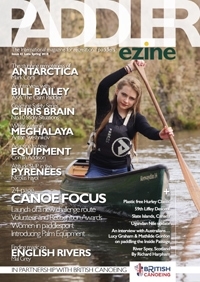As the nights draw in and the landscape turns from golden hues to muted shades, the influx of winter migratory birds is a welcome sight in the colder months. These winter visitors bring a splash of colour and a symphony of sound to our shores before heading back to their breeding grounds in spring. Here are five migrant birds to spot when paddling this winter:
Why do birds migrate?
In autumn, birds slowly make their way south towards their wintering grounds where they can enjoy a mild climate and an abundance of food. We’re rather jealous! But it’s not a holiday for them, migration is all about survival. In fact, some species travel an incredible 6,00 miles to Britain. Some use it as a pitstop, stopping for days or even weeks to refuel for the rest of their journey. While other species overwinter here before departing in spring.
See if you can spot these five winter visitors on your paddles:
Pink-footed geese

Migrates from: Greenland and Iceland.
Appearance: Pink-footed geese are one of Britain’s smaller geese, being only slightly bigger than a mallard duck. They have short, pink bill and pink legs.
Where to spot: They stop off at favoured sites in Scotland and then filter south into England. Around 300,000 of them winter on the east coast and around 50,000 on Lancashire’s coast. Listen out for their distinctive honking sounds and keep your eyes on the sky at dawn and dusk to see their characteristic V-formations.
Water pipits

Migrates from: Mountainous areas of southern Europe and Asia.
Appearance: Known as ‘little brown jobs’, they are greyish-brown above and pale below with streaks on their breast. They have a pale stripe over their eye, a slender bill and dark legs.
Where to spot: These much anticipated winter visitors are mostly found in Wales and eastern and southern England. While they can be found in Scotland they are a rare sight. They favour freshwater habitats, though they can tolerate brackish estuarine conditions, such as those found on the outer Thames and outer Severn. The good thing about water pipits is that they are loyal to certain sites, so you can be fairly confident you’ll see one in winter if you go to the right place. Look out for them feeding among the seaweed and grass.
Redwings

Migrates from: Iceland, the Faroes and Scandinavia.
Appearance: They’re similar in appearance to the song thrush and mistle thrush but are much smaller. Did you know they are the smallest thrush found in Britain? You can identify them by their distinctive creamy eyestripe and orange-red patches under their wing.
Where to spot: They travel over the North Sea and descend in hedgerows at night. Paddle as quietly as you can and listen for the high pitched ‘seep’ as they swoop through the dark. During the day they can be seen in large flocks feasting on berries.
Starlings

Migrates from: Eastern Europe.
Appearance: Starlings have glossy black feathers with iridescent markings that shine blue and green in the sunlight. In the winter months they are also covered in small white spots. We think they look like they are wearing a cloak of stars!
Where to spot: The number of starlings in Britain almost doubles in winter. Our resident starlings are joined by thousands of migrant birds from Eastern Europe. When you’re paddling look out for huge, whirling flocks at dusk, known as murmurations.
Bewick’s swan

Migrates from: Siberia.
Appearance: Bewick’s swans are the smallest of the swan species found in Britain. They are not much bigger than a Canadian goose. Adults are white all over with a yellow and black bill and young birds are greyish with a pinkish bill.
Where to spot: After they’ve made their long, perilous migration from Siberia, they can be spotted in farmland, freshwater wetlands and coastal bays. Listen out for their distinctive calls which sound rather like an excited dog!
We hope you get chance to spot these winter migrant birds on your paddles! Don’t forget to take your camera with you so you can capture them. For more inspiration on wildlife to spot on your paddles, check out our blogs on paddling and the environment.
To ensure that you paddle responsibly and do not disturb wildlife, follow our You, Your Canoe and the Marine Environment guidance.


 Go Paddling
Go Paddling Clear Access Clear Waters
Clear Access Clear Waters Paddles Up Training
Paddles Up Training Clubhouse
Clubhouse Services Login
Services Login

